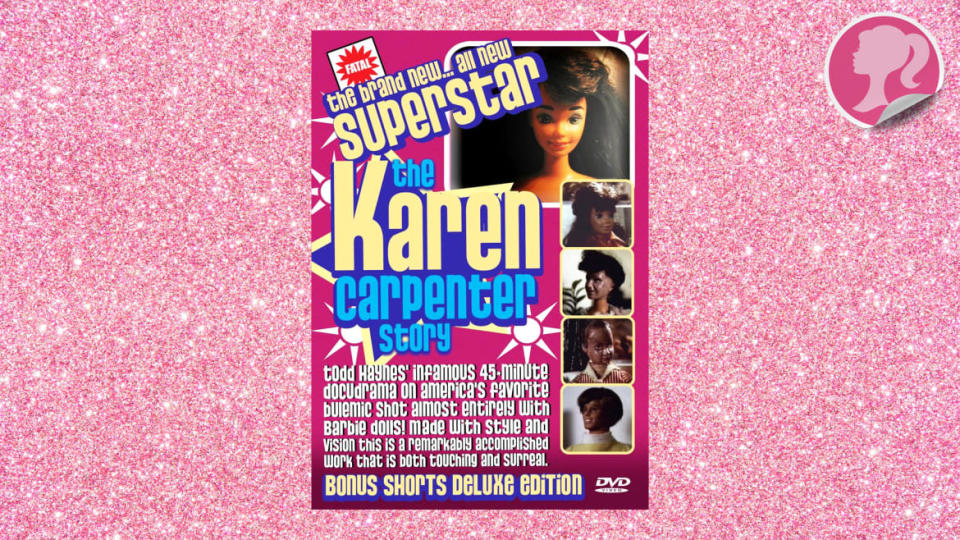The Banned Karen Carpenter Biopic Was Barbie at Her Most Subversive

- Oops!Something went wrong.Please try again later.
- Oops!Something went wrong.Please try again later.
- Oops!Something went wrong.Please try again later.
It’s Barbie Week at The Daily Beast’s Obsessed, celebrating the doll’s pop-culture history, our favorite Barbie memories, and a certain major movie. Read all of our coverage here!
Barbie has starred in numerous films and television programs, and—on screen and off—she’s played countless roles, from doctor and dancer to flight attendant and computer engineer. Yet perhaps her greatest part is the one that the powers-that-be have tried to keep hidden from view: that of legendary singer Karen Carpenter, in a cult classic that heralded the arrival of one of America’s most daring modern directors.
Superstar: The Karen Carpenter Story is an early 43-minute short film by Todd Haynes, the acclaimed auteur behind Safe, Far from Heaven, Carol, and the upcoming May December (which premiered at Cannes and will open this fall’s New York Film Festival). Haynes recounts the film’s iconic title character’s meteoric rise and anorexia nervosa-driven demise through avant-garde means, highlighted by the decision to use Barbie dolls to tell its tale. A deliberately artificial and stylized biopic that also features live-action sequences, archival news and TV clips, schizoid static imagery, text cards and narration, it was an underground hit upon its 1987 debut. Its reputation has only grown in the following decades, thanks in large part to the fact that it’s been almost impossible to find since 1990, when it was pulled from distribution due to copyright-infringement claims.

The Carpenters perform on stage at Nippon Budokan, Tokyo, Japan, 31st May 1974. Karen Carpenter, Richard Carpenter.
While Superstar: The Karen Carpenter Story was reportedly suppressed by Karen’s brother and musical partner Richard because of its unauthorized use of Carpenters songs (“(They Long to Be) Close to You,” “We’ve Only Just Begun,” “Superstar”), there’s no doubt that its stinging portrayal of him and his parents contributed to its fate. (The film is now available to view through unofficial channels.) Co-written with Cynthia Schneider and finished while he was completing his MFA at Bard College, Haynes’ eclectic film is a compassionate portrait of Karen and an informative primer on anorexia. It’s also a brutal censure of the culture and home life that instigated the singer and drummer’s fatal condition, which took her life at the age of 32. Superstar is an audacious multimedia work of investigation, empathy and critique, and key to its power is its form, beginning—most memorably—with its front-and-center use of Mattel’s famous doll.
Barbie isn’t just a unique dramatic tool for Haynes in Superstar: The Karen Carpenter Story; rather, as a symbol of cheery American purity and beauty, she’s the ideal figure to “play” the similarly wholesome and fresh-faced Karen. That the director then pulls back the curtain of the artist’s life to reveal dysfunction, abuse, and ugliness via his Barbie pantomimes speaks to his caustic appraisal of American stereotypes about feminine attractiveness and female agency, all of which are embodied by the toy. Interspersing glimpses of Richard Nixon, the Vietnam War (and protests of it), and sunshiny sitcoms and variety shows (All in the Family, The Brady Bunch, The Partridge Family) into his action proper, Haynes conflates Barbie and Karen in order to put the lie to the superficially upbeat sheen of the ’70s. In so doing, he exposes its violent, corrosive underbelly.
Superstar begins on Feb. 4, 1983, with a shot from the POV of Karen’s mother Agnes as she discovers her daughter dead in the closet of their Downey, California, house. It then flashes back to Karen’s childhood in this familial home, which is ruled by the imperious and controlling Agnes and her husband Harold. Upon hearing Karen’s amazing singing voice, Agnes pairs her with older brother Richard, and they’re soon visiting with Mr. A&M (a stand-in for record exec Herb Alpert), who praises them as “a couple of kids next door.” Alpert then convinces the Carpenters that “all you have to do is put yourself in my hands.” It’s a Faustian deal, and its horror is underscored by dark shadows, the recurring image of a human hand extending outward, a female scream, and a clip of a nude Holocaust victim being thrown into a mass grave.

Film still from the film Todd Haynes’ Superstar: The Karen Carpenter Story
Haynes’ commingling of real and reproduced trauma and terror is at once campy and shocking, and he continues to mine that vein throughout the remainder of Superstar: The Karen Carpenter Story. At the same time, he seriously and sympathetically considers Karen’s ill-treated plight. On-screen text (sometimes in black and superimposed over imagery, so that it’s difficult to read) provides details about anorexia; in one stunning sequence, it addresses how the disease “reveals a complex internal apparatus of resistance and control,” while, at the same time, the narration discusses the post-WWII rise of supermarkets, refrigeration, and bountiful food availability. Coupled with scenes in which the camera pulls back from a performing Karen to leave her stranded in isolated spotlight, and others that brutally take down Agnes, Howard, and Richard—who are depicted as managing Karen’s every move to a stifling degree—the film presents a micro and macro view of a pressure-packed society that dictates how women should act, look, and be.
I Toured Barbie’s (and Ken’s) Real-Life Malibu DreamHouse
Superstar posits Karen’s anorexia as a byproduct of her desire to both conform to oppressive beauty standards (to a twisted and unhealthy degree) and rebel against her the domineering control of her family and profession—an idea articulated by text that reads, “Anorexia can thus be seen as an addiction and abuse of self-control, a fascism over the body in which the sufferer plays the parts of both dictator and the emaciated victim who she so often resembles.” Such academic notions are wedded to parodic on-the-street interviews with people asking PSA-style questions about anorexia, as well as mournful snapshots of Karen’s day-to-day ordeals. Throughout the film, as in her life, she must deal with both a brother whose primary concern is himself (“What are you trying to do, ruin both our careers?!?”) and a mother who won’t loosen her grip on her daughter. Swiftly, it also touches upon her brief marriage to real estate developer Thomas Burris, which may have further pushed her over the edge—culminating in her tragic, Ipecac-fueled death.

Key Art for the film Todd Haynes’ Superstar: The Karen Carpenter Story
A cheeky formal mélange whose melancholy is most poignantly expressed by The Carpenters’ own hits (which, during late passages, slow until they’re warped), Superstar: The Karen Carpenter Story is a biopic like no other, and much of its lasting effect comes from Haynes’ canny employment and manipulation of Barbie, that paragon of mid-century American innocence, glamour, and virtue. Ultimately shaving down the doll’s face to make Karen appear thinner and utilizing additional toys for supporting characters—including, tellingly, a picture-perfect Ken doll for the unsavory Richard—Haynes damns through striking style and substance. Barbie has never been so captivating, or so moving.
Get the Daily Beast's biggest scoops and scandals delivered right to your inbox. Sign up now.
Stay informed and gain unlimited access to the Daily Beast's unmatched reporting. Subscribe now.

